The Sandy Bridge Preview
by Anand Lal Shimpi on August 27, 2010 2:38 PM ESTAdobe Photoshop CS4 Performance
To measure performance under Photoshop CS4 we turn to the Retouch Artists’ Speed Test. The test does basic photo editing; there are a couple of color space conversions, many layer creations, color curve adjustment, image and canvas size adjustment, unsharp mask, and finally a gaussian blur performed on the entire image.
The whole process is timed and thanks to the use of Intel's X25-M SSD as our test bed hard drive, performance is far more predictable than back when we used to test on mechanical disks.
Time is reported in seconds and the lower numbers mean better performance. The test is multithreaded and can hit all four cores in a quad-core machine.
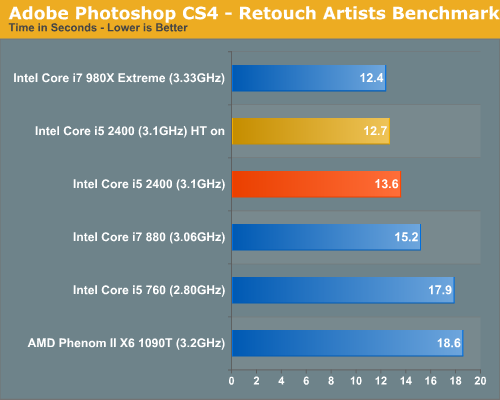
Right off the bat Sandy Bridge is killer. In our Photoshop test it’s faster than its closest quad-core price competitor, faster than its identically clocked Lynnfield, faster than AMD’s fastest and loses out only to Intel’s $999 Core i7 980X. That being said, it only takes about 9% longer to complete our benchmark than the 980X.
DivX 6.5.3 with Xmpeg 5.0.3
Our DivX test is the same DivX / XMpeg 5.03 test we've run for the past few years now, the 1080p source file is encoded using the unconstrained DivX profile, quality/performance is set balanced at 5 and enhanced multithreading is enabled:
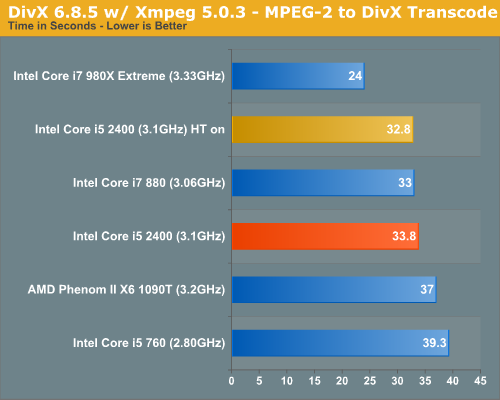
While not the most stressful encoding test, it’s still a valid measure of performance and once again, Sandy Bridge is faster than all. In this case we’re faster than the Core i5 760 (~16%) and just behind the Core i7 880. Clock for clock there's not a huge improvement in performance here (HT doesn't seem to do much), it's just a better value than the 760 assuming prices remain the same.
x264 HD Video Encoding Performance
Graysky's x264 HD test uses the publicly available x264 encoder to transcode a 4Mbps 720p MPEG-2 source. The focus here is on quality rather than speed, thus the benchmark uses a 2-pass encode and reports the average frame rate in each pass.
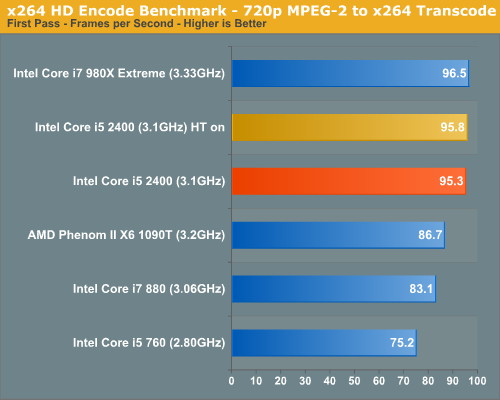
Lightly threaded performance is much improved - the 2400 is 14.6% faster than the Core i7 880.
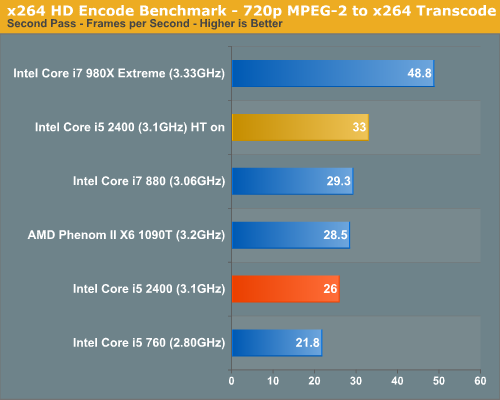
The actual encoding pass favors more threads, so we see a big improvement over the 760 (19%) but it falls short of the Core i7 880. Turn HT on and we get a 12.6% improvement over an identically clocked/configured Lynnfield.
Note that CPU based video encoding performance may not matter if Intel implemented a good video transcode engine in Sandy Bridge.
Windows Media Encoder 9 x64 Advanced Profile
In order to be codec agnostic we've got a Windows Media Encoder benchmark looking at the same sort of thing we've been doing in the DivX and x264 tests, but using WME instead.
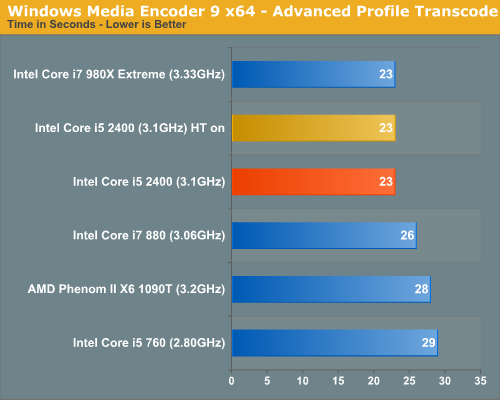
Performance in WME rarely scales anymore. Our benchmark doesn’t scale well beyond 4 cores and the only hope for performance are increases in clock speed or IPC. Sandy Bridge delivers the latter.
A 20% increase in performance vs. the similarly clocked 880 in a test that doesn’t scale with anything but IPC tells you a lot. Compared to the Core i5 760, Sandy Bridge is 26% faster.










200 Comments
View All Comments
DanNeely - Friday, August 27, 2010 - link
Maybe, but IIRC Apple's biggest issue with the Clarkdale platform on smaller laptops was wanting to maintain CUDA support across their entire platform without adding a 3rd chip to the board, not general GPU performance. Unless the Intel/nVidia lawsuit concludes with nVidia getting a DMI license or Intel getting a CUDA license this isn't going to change.Pinski - Saturday, August 28, 2010 - link
I don't think it has anything to do with CUDA. I mean, they sell Mac Pros with AMD/ATI Cards in them, and they don't support CUDA. It's more of OpenCL and high enough performance. However, just looking at these new performance, I'm willing to say that it'll be the next chip for the MBP 13" easily.Pinski - Saturday, August 28, 2010 - link
Well, wait never mind. Apparently it doesn't support OpenCL, which basically puts it out of the picture for Apple to use.starfalcon - Saturday, August 28, 2010 - link
Hmm, they really want all of the systems to have OpenCL?I don't have OpenCL and I don't care at all and I have CUDA but have only used it once.
320M doesn't even have OpenCl does it?
Seems like it would be ok for the less expensive ones to have Intel graphics and the higher end ones to have CUDA, OpenCL, and better gaming performance if someone cares about those.
They'll keep on upgrading the performance and features of Intel graphics though, who knows.
Veerappan - Thursday, September 2, 2010 - link
No, just ... no.Nvidia implements an OpenCL run-time by translating OpenCL API calls to CUDA calls. If your card supports CUDA, it supports OpenCL.
The 320M supports OpenCL, and every Apple laptop/desktop that has shipped in the last few years has as well.
A large portion of the motivation for OS X 10.6 (Snow Leopard) was introducing OpenCL support.. along with increasing general performance.
There is a large amount of speculation that OS X 10.7 will take advantage of the OpenCL groundwork that OS X 10.6 has put in place.
Also, in the case that you have a GPU that doesn't support OpenCL (older Intel Macs with Intel IGP graphics), Apple has written a CPU-based OpenCL run-time. It'll be slower than GPU, but the programs will still run. That being said, I highly doubt that Apple will be willing to accept such a performance deficit existing in a brand new machine compared to prior hardware.
Penti - Saturday, August 28, 2010 - link
It has more to do with nVidia's VP3 PureVideo engine which they rely on for video acceleration. It's as simple as that.Which is why they only find their place in the notebooks. It's also a low-end gpu with enough performance to say run a source game at low res. And they have more complete drivers for OS X.
CUDA is a third party add on. OpenCL isn't.
burek - Friday, August 27, 2010 - link
Will there be a "cheap"(~$300) 6-core LGA-2011 replacement for i7 920/930 or will Intel limit the 6/8 cores to the high-end/extreme price segment ($500+)?DJMiggy - Friday, August 27, 2010 - link
yea I doubt that will happen. It would be like trying to SLI/crossfire an nvidia to an ati discrete. You would need a special chip like the hyrda one.DJMiggy - Friday, August 27, 2010 - link
Hydra even. Hydra Lucid chip.Touche - Friday, August 27, 2010 - link
Questionable overclocking is bad enough, but together with..."There’s no nice way to put this: Sandy Bridge marks the third new socket Intel will have introduced since 2008."
"The CPU and socket are not compatible with existing motherboards or CPUs. That’s right, if you want to buy Sandy Bridge you’ll need a new motherboard."
"In the second half of 2011 Intel will replace LGA-1366 with LGA-2011."
...it is just terrible!
I'll definitely buy AMD Bulldozer, even if it ends up a bit slower. At least they have some respect for their customers and an ability of forward thinking when designing sockets (actually, Intel probably has it too, but just likes to milk us on chipset purchases also). And I am no fanboy, 4 of my 7 PC's are Intel based (two of those 4 were my latest computer purchases).